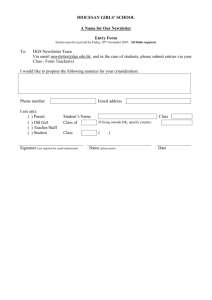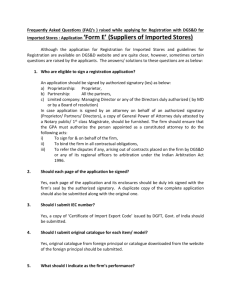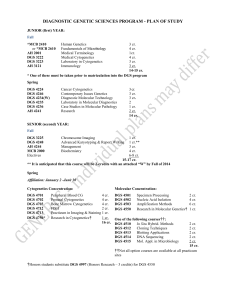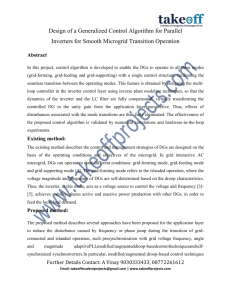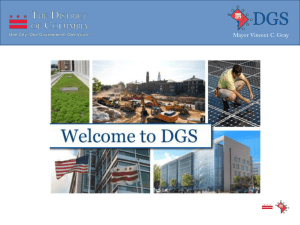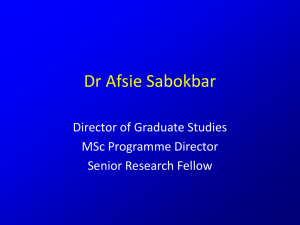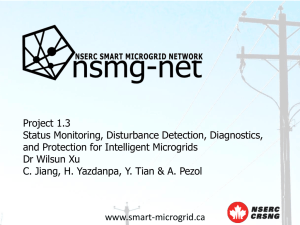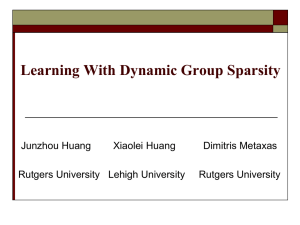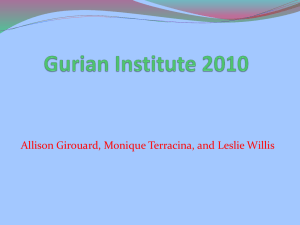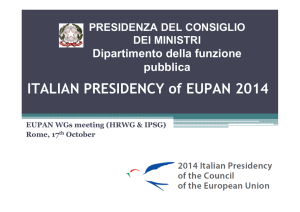Q31_Attachment _Transition_and_centralization
advertisement
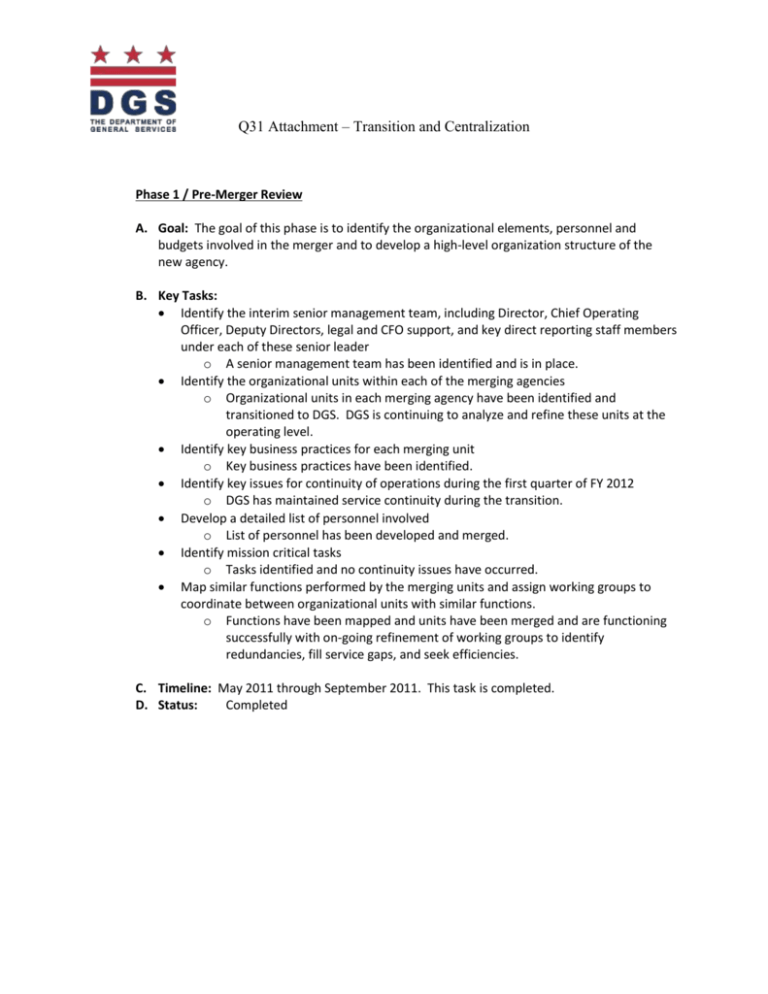
Q31 Attachment – Transition and Centralization Phase 1 / Pre-Merger Review A. Goal: The goal of this phase is to identify the organizational elements, personnel and budgets involved in the merger and to develop a high-level organization structure of the new agency. B. Key Tasks: Identify the interim senior management team, including Director, Chief Operating Officer, Deputy Directors, legal and CFO support, and key direct reporting staff members under each of these senior leader o A senior management team has been identified and is in place. Identify the organizational units within each of the merging agencies o Organizational units in each merging agency have been identified and transitioned to DGS. DGS is continuing to analyze and refine these units at the operating level. Identify key business practices for each merging unit o Key business practices have been identified. Identify key issues for continuity of operations during the first quarter of FY 2012 o DGS has maintained service continuity during the transition. Develop a detailed list of personnel involved o List of personnel has been developed and merged. Identify mission critical tasks o Tasks identified and no continuity issues have occurred. Map similar functions performed by the merging units and assign working groups to coordinate between organizational units with similar functions. o Functions have been mapped and units have been merged and are functioning successfully with on-going refinement of working groups to identify redundancies, fill service gaps, and seek efficiencies. C. Timeline: May 2011 through September 2011. This task is completed. D. Status: Completed Q31 Attachment – Transition and Centralization Phase 2 / Develop a Detailed Organizational Structure A. Goal: Develop the detailed organizational structure for each unit within DGS. Develop procedures to manage workflow within the new organization that ensure compliance with budget allocations established by the Council and which ensure that all agencies receive the required support. B. Key Tasks: Develop detailed organizational structure for each of the key operating divisions o An organizational structure for each operating division has been developed, DGS is continuing to review and refine these working groups to identify redundancies, fill service gaps, and seek efficiencies . An initial iteration of this exercise resulted in identifying 35.25 vacant positions that will not be filled resulting in $2.9 million FY13 savings. Define the physical location(s) for each new unit, including an assessment of the physical requirements for each such unit o Each unit has an existing location. Several management functions, such as human resources, legal, and communications were moved to Reeves in December 2011. DGS has consolidated staff to Reeves and 1250 U Street with a number of operations, maintenance and PSPD staff remaining at current locations distributed through the city. Assign merged staff to the new units and locations o Merged staff has been assigned to new units and locations. o OCA and DGS met with labor representatives to discuss planning and implementation of DGS o All DGS staff received letters from DCHR describing DGS’s mission, explaining the transition, advising where and who to report to, providing contact information for additional questions and including a FAQ sheet. o DGS conducted a series of agency-wide webinars to communicate with the entire staff and to address questions and concerns related to the agency’s direction and goals. o DGS is continuing to review and refine, through an employee cross-walk, the roles, responsibilities and reporting structure for the agency. Assess skills and capabilities of combined staff o DGS senior management conducted a series of meetings to analyze the skills and capabilities of the senior management staff (Tier 1 Meetings). o DGS senior management conducted a series of meeting with the leaders of the operating units to review and analyze the skills and capabilities of the staff and structure of these units and to begin identifying redundancies, existing services gaps and efficiencies. (Tier 2 Meetings) o DGS converted approximately 125 positions from term appointments to permanent appointments. This conversion was be accomplished through a competitive process. Q31 Attachment – Transition and Centralization Assess additional skills, resources, etc. that may be required in order to meet functional requirements o DGS senior management conducted a series of meeting with the leaders of the operating units to review and analyze the skills and capabilities of the staff and structure of these units and to begin identifying redundancies, existing services gaps and efficiencies. (Tier 2 Meetings) Develop points of contact between each of the new units and the agencies served by those units to ensure service delivery o Operating unit leaders have met with and continue to meet with client agencies to ensure delivery of services. C. Timeline: October 1st through December 31st D. Status: Completed Q31 Attachment – Transition and Centralization Phase 3 / Re-Align Staff & Resources A. Goal: Implement the realignment mapped in Phase 2. B. Key Tasks: Relocate staff to new location(s), if required o DGS consolidated a majority of the DGS staff to Reeves and 1250 U Street with a number of operations, maintenance and PSPD staff remaining at current locations distributed through the city. (there are some moves within Reeves still pending). Stand-up new organizational structure o DGS’s organizational structure was developed as of October 1, 2011 and undergone a series of adjustments and refinements. Senior management believes that the managers now in place and the organizational structure are appropriate to complete the transition, lead and manage the agency, and achieve the agency’s goals. Activate new business practices o DGS successfully integrated all facilities under its management and operation, including a number of DPR, FEMS, and MPD facilities that were not allocated sufficient funding to adequately operate and maintain them. Through merger efficiencies, DGS has been able to begin upgrades in operation and maintenance at these facilities. o On October 6, 2011, DGS adopted its own procurement regulations pursuant to the Procurement Practices Reform Act and the procurement functions have been merged into a single unit. o DGS is expanding the Work Investment Program, begun with the FY2011 Phase I school modernizations, to additional capital projects. o DGS is continuing with the implementation, begun under DRES, of the Archibus portfolio management system. This system will serve as an integrated building management for District facilities. o All DGS properties have been merged into a central property database. o Recycling programs have been merged. o DGS has developed and is continuing to review and analyze a zero-based facilities budget for routine and preventative operations and maintenance for all facilities. Monitor impact on user/client agencies o DGS continues its close work with client agencies, DCPS, DPR, MPD, and FEMS, in particular to ensure that facility planning, modernization, operation and maintenance are serving the agency’s needs. C. Timeline: January 1st through June 30th D. Status: Completed Q31 Attachment – Transition and Centralization Phase 4 / Shake Down of Operations A. Goal: Assess impact of new organizational structure and fine-tune B. Key Tasks: Monitor performance delivery o With the successful merger of the component agencies, DGS is now focused on improvements to service delivery, identifying redundancies, existing services gaps and efficiencies and executing the initiative identified in Phase 3 above. o DGS has been organizing, synthesizing and reviewing a number of both published and internal performance measures from the constituent agencies in an effort to develop a comprehensive, appropriate, and targeted performance plan to better manage the agency and assess performance. o DGS is developing a list of special projects and initiatives, some of which were identified during the planning phase and others that have occurred since DGS’s inception, to be started over the. Survey key stakeholders at client agencies o Through the continuation of the work order system and the implementation of the Archibus system, DGS receives feedback from its end users. DGS has developed working relationships with its client agencies, DCPS and DPR in particular, to plan and execute their facility needs. DGS has also worked to planning and communication tools work with agencies that are relocating or expanding to ensure that facility moves occur with minimum disruption. C. Timeline: Complete by end of FY 2012 D. Status: Complete
